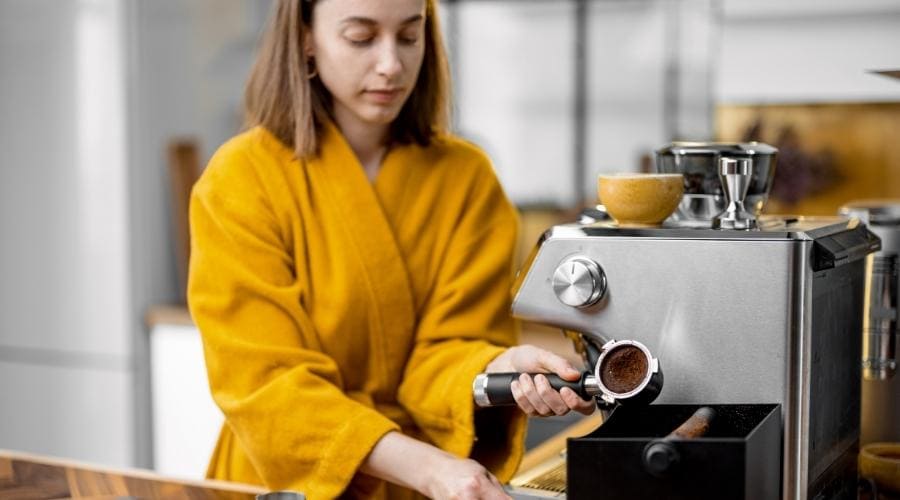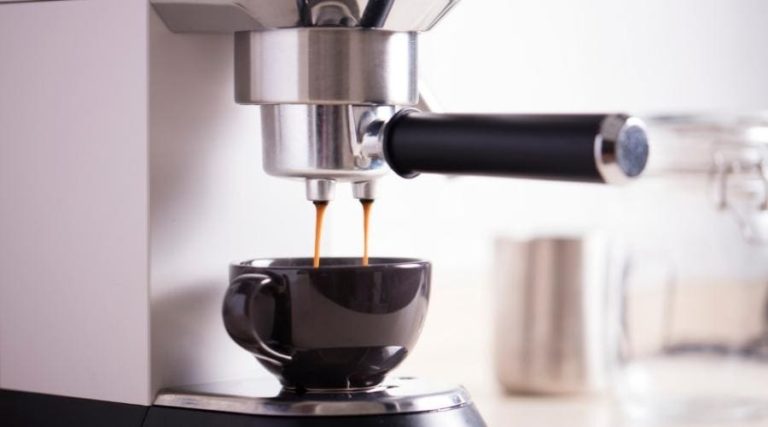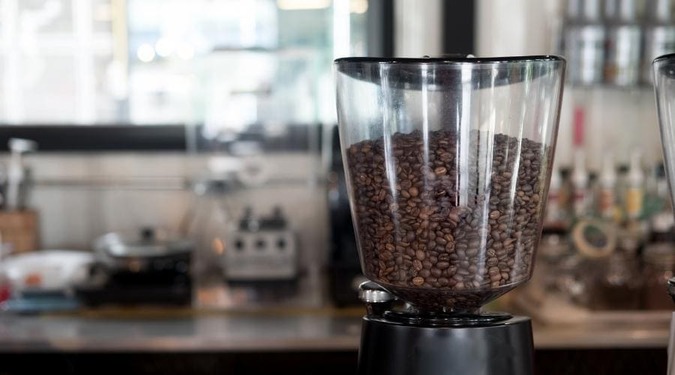Different countries have different household voltage, plug types, and frequencies. In north america specifically, the majority of the sockets operate between 100 and 140V, and the large appliances operate at 240 voltage supplies.
On the other hand, Espresso machines operate in the 110-volt range and also in the 220-volt range.
In this article, we’ll go over everything you need to know about 110V vs 220V Espresso machine voltages.
110 Vs 220 volt Appliances – How It Works
Power transformers deliver electricity to your home. When you connect an appliance to the power transformer’s two hot wires, it receives 220 volts. In addition, if you connect your device to a single hot wire and a ground, it will receive 110 volts.
Indoor lights and fans operate on a 110-volt power supply, while Larger appliances such as dryers, air-conditioners, and washing machines; operate more efficiently on 220 volts.
Do I get both 110V and a 220V power supply?
- Most metropolitan locations in the United States and other industrialized countries provide families with 110V and 220V power.
- Remote places get a standard household power supply.
- The standard household voltage is 110V in the United States and 220V in the United Kingdom.
- Different countries have different standard domestic voltages.
What happens if I plug a 220 espresso into a 110V socket?
In this case, the power drawn would be one-fourth. So, the motors in the espresso will begin to stall or run slowly, and the cooking elements might not come to the desired temperature. Most likely, There would be no damages, but your machine won’t work.
110V vs 220V Espresso machine – Which is Better?
The espressos come in both 110V and 220V. Which is better? Which one should I choose?
The following points help you make the right decision:
Energy Efficiency
A 220-volt coffee machine outperforms a 110-volt machine in terms of energy efficiency.
Reason:
- Because a 110-volt machine taps more energy.
- This does not imply that a 110-volt coffee machine uses more electricity.
- It means your 110-volt coffee maker can handle more power.
In simple terms: When you eat more calories, your energy level rises. Right? Taping more power is essentially the same.
Cost Efficiency
A 220-volt coffeemaker is more economical than compared to 110-volt.
Reason: A 220-volt machine needs less current to transmit the same power.
In simple terms:
- Let us assume you ordered pizza from a nearby store.
- Two delivery boys are starting at the same time.
- One is a bodybuilder (220-volt machine) and the other is a regular person (110-volt machine).
- The bodybuilder delivers the pizza at ease.
- This is because his muscle power is more; he consumes less energy.
- Similarly, the 220-volt machine draws in a lesser current.
Therefore, a 220-volt coffee machine has greater cost efficiency.
Hazard level
A 220-volt coffee machine is more dangerous than a 110-volt machine.
Reason:
The 220-volt machine has a higher voltage. And so, the current flow is also high. Therefore, the chances of electrocution are more in 220V espresso.
In simple terms: An electric shock from a 110-volt machine is less painful.
Countries using 110-volt:
Most of the Americas use 110-volt. United States, Japan, Haiti, Guam, Virgin Islands, Panama, Dominican Republic, Jamaica, Taiwan
Countries using 220-volt:
Most of the countries in Europe use 220-volt. UK, India, China. Australia uses 240-volt.
Wires
The 220V espresso requires 10 guage (diameter-2.5 mm) wires. And 110V espresso requires 12 guage (diameter-2 mm) wires. The thickness of wires used in 220V espresso is more than 110V espressos. This is because; the current consumption of 220V espresso is more.
Heat generated
The cables in the 220-volt coffee machine generate more heat than the 110V cables.
Reason:
- When electrons flow through a wire, resistive forces cause friction. Frictional forces generate heat.
- Because the thickness of the wires used in 220V machines is greater than that of 110V machines, 220V espresso generates larger frictional forces and more heat.
- What is the science behind the heat generated?
- The amount of copper in 220V machines (or wires) is more.
- The greater the amount of copper in the wire, the greater the frictional forces and higher the heat energy created.
The heat produced by coffee machines has a significant impact on the taste and scent of the coffee. Overheating gives a sour taste to your coffee. Make sure you choose the correct voltage for your machine.
Choosing 220V for a low-capacity espresso will overheat your coffee.
Load capacity
A 220-volt coffee maker can carry more loads.
Hotwires
A 220-volt coffee machine requires two hot wires. These wires are usually red and black. A 110-volt espresso, on the other hand, requires only one hot wire connection.
Reason: Your home socket gets power from the distribution transformer. In the case of 220-volt lines, the secondary side of the transformer directly connects to the domestic socket; not grounded.In 110-volt lines, one end is grounded.
In simple terms:
- Take a gas line of capacity X, for instance, and it supplies gas to 2 households.
- The capacity of the gas line at the source is X.
- Its capacity divides by X/2 at home.
- The same logic applies to hotwire usage.
The espresso (or socket), in the case of a 220 volt, is directly connected to the transformer (gas source X). As a result, it requires two hot wires. In 110-volt espresso, just one end is connected to the transformer, while the other end is grounded. And therefore, only one hot wire is required.
Repairs and replacements
The 110-volt coffee machines are easy to repair as compared to 220-volt espresso.
Reason: The 110-volt motors are popular and widely used. Most of the coffee machine makers and users are in Japan and USA. And the standard in these countries is 110-volt. So, does that mean there are no coffee machine makers in the rest of the world? No, it is just that the numbers are more in the USA. Therefore, the popularity of 110-volt coffee machines is comparatively more. And so it is easy to find 110V repair services.
Protection against surges and spikes
Both 110-volt and 220-volt espresso machines require protection against surges and spikes.
What are Surges?
Surges are transient increases. That is, when the machine is turned ON, there is a large inflow of current.
What are Spikes?
Spikes are a sudden increase in voltage. It occurs during lightning or due to the sudden release of stored energy. It can also occur through phone lines, cables, and power lines.
Reason: Surges and spikes harm electronic components of your espresso machine, such as heating elements, thermostats, pressure gauges, and so on.
If you do not have surge or spike protection for your espresso, surges and spikes may damage your machine.
Protection against surges and spikes
A surge protector or spike arrestor controls the spikes in voltage and current. People usually refer to them as power surge protectors or surge protectors.
How to choose the correct surge arrestor for your coffee machine?
- Check on the joule rating.
- Higher the rating, the stronger the protection.
- A surge protector with a joule rating of 1000 to 2000 joules will provide sufficient protection to your coffee machine.
However, if you are in an area with frequent thunderstorms and lightning, choose a higher rating (more than 2000 joules).
Ground Fault
The ground fault occurs in both 110-volt and 200-volt coffee machines. However, the chance is more in 110-volt coffee machines than the 220-volt.
Reason: Ground fault occurs when there is a break in the low-resistance grounding path. During the occurrence of ground faults, the current takes an alternate path to the ground resulting in injuries.
Does ground fault occur in a 220-volt espresso machine?
The occurrence of a ground fault is rare in a 220-volt espresso machine. The ground fault occurs due to following reasons:
- Two wires come in contact with each other
- Surge of electricity
- Poorly insulated or damaged wires
- Water leaking into the breaker box
Most of the 220-volt espresso machines receive power through two hot wires. They do not have a ground connection. Some of the three-wired (2 hot wires and an earth wire) coffee machines come with an earth connection.
Place of operation
Most of the developed countries distribute both 220 V and 110 V power. On the other hand, developing countries stick to a single type of voltage operation. Learn your domestic power specifications before buying a coffee machine.
If you live in a small town, 220-volt may not be available. What if you did not know the fact and bought a high-rating coffee machine.
220-volt espresso machine Examples?
In the United States, there are extremely few 220-volt espresso machines. NESCAFE Dolce Gusto is one of them. Very few manufacturers choose to sell 220-volt products in the US.
Dual Voltage Espresso machine (examples)
Dual Voltage espresso machines can operate on both 110 and 220 volts. Here are a few examples of dual voltage espresso machines:
• YBZS Professional All-in-One Espresso Machine (Includes a bean grinder and a milk frother):

• BUNN Axiom DV-3

Do Nespresso machines come in dual voltage?
The answer is yes and no.
The Nespresso machine voltage ratings are country-specific. For instance, in the US, the operating voltage is 110 volts. And therefore, the Nespresso machines sold in the US are 110 volts. The machine sold in the UK and other European countries where the operating voltage is 220V is in the corresponding range.
In that case, can I buy 220-volt Nespresso in the US? No, you cannot. You may buy it from an importer or order it online from the UK or other foreign countries.
How to use a 220V Nespresso machine in the US?
- Use a step-up transformer or a step-up converter.
- Check on the wattage of the transformer.
- Ensure that the transformer power rating (wattage) is the same as that of the Nespresso.
- The machine will not work if the wattage is lower or higher.
How to find out the required wattage of the transformer?
- Check on the label of your Nespresso, in the manual, or on its backside.
- If you cannot find it, figure out the amperage of your machine and multiply it by voltage rating.
- Never operate the coffee machine at a higher power than the transformer.
- Running the espresso at a higher wattage will harm your transformer and your Nespresso.
How to convert a 220V Espresso machine to 110V?
In the same way, you convert a Nespresso machine. Purchase a converter and perform the same steps described above for Nespresso machines.
Will it work? Yes, because the operational mechanism and concepts of espresso and Nespresso machines are identical.
Then, what is the difference?
Nespresso machines make single-shot coffees. Espresso, on the other hand, makes double-shot coffees.
The Verdict?
Both 110V espresso and 220V espresso have their pros and cons.
If you live in a metropolitan area, you may opt for a 220V coffee machine as it is energy-efficient and cost-efficient. If you are a frequent traveller (between the USA and Europe), a dual voltage espresso is the right choice.
Make a wise choice! Good luck!!








